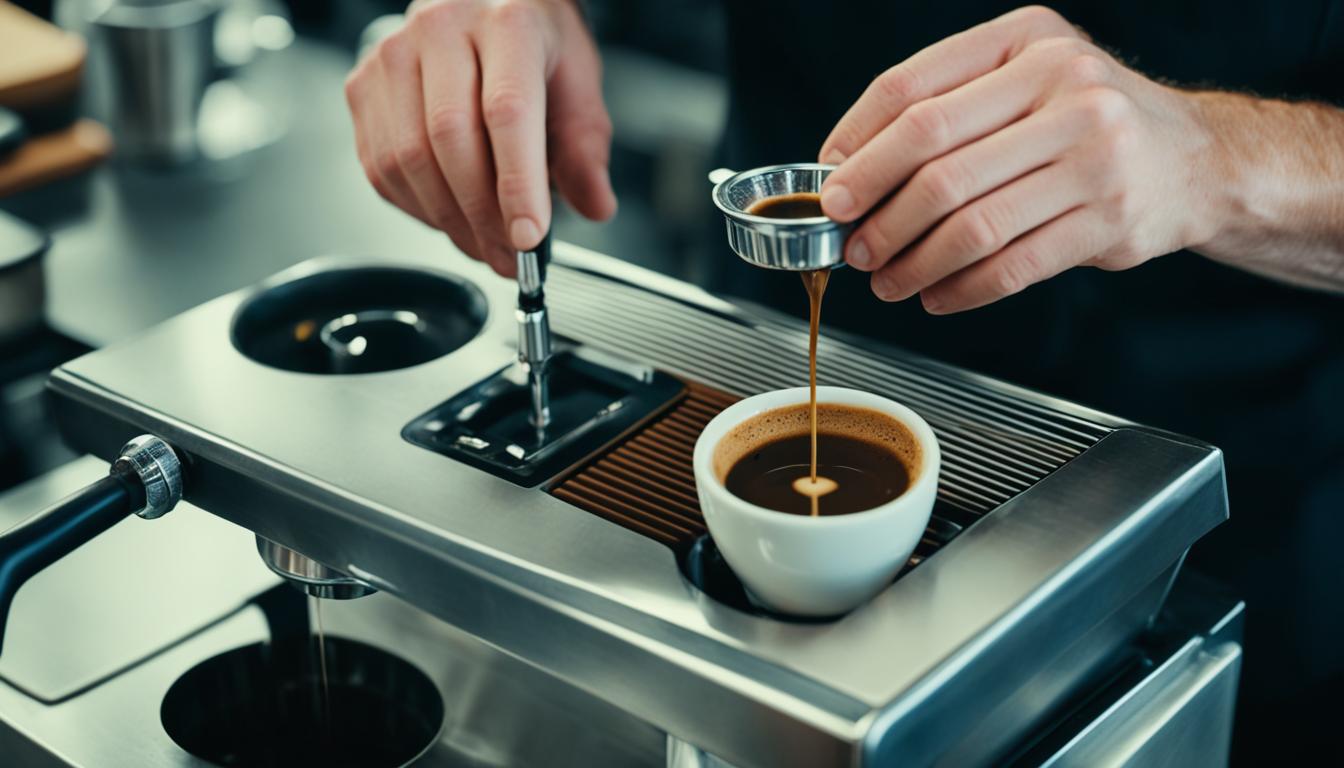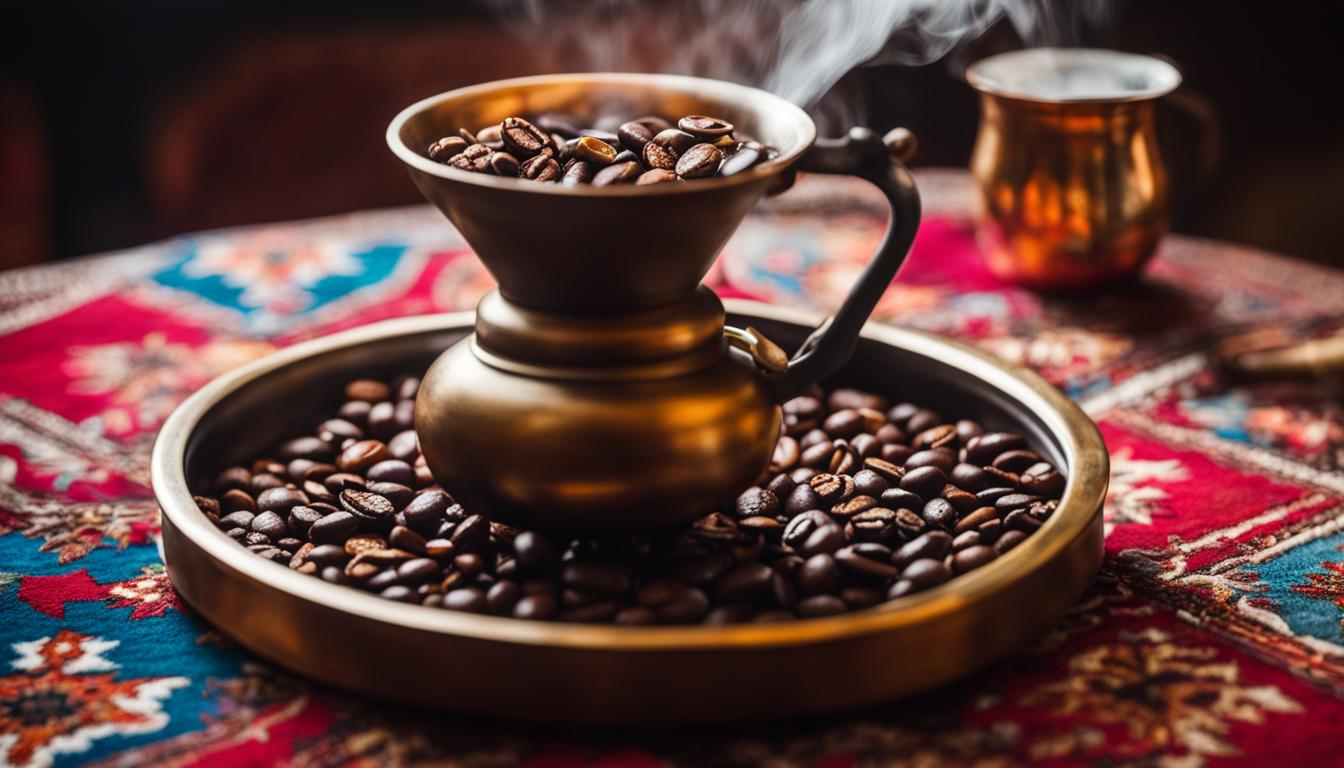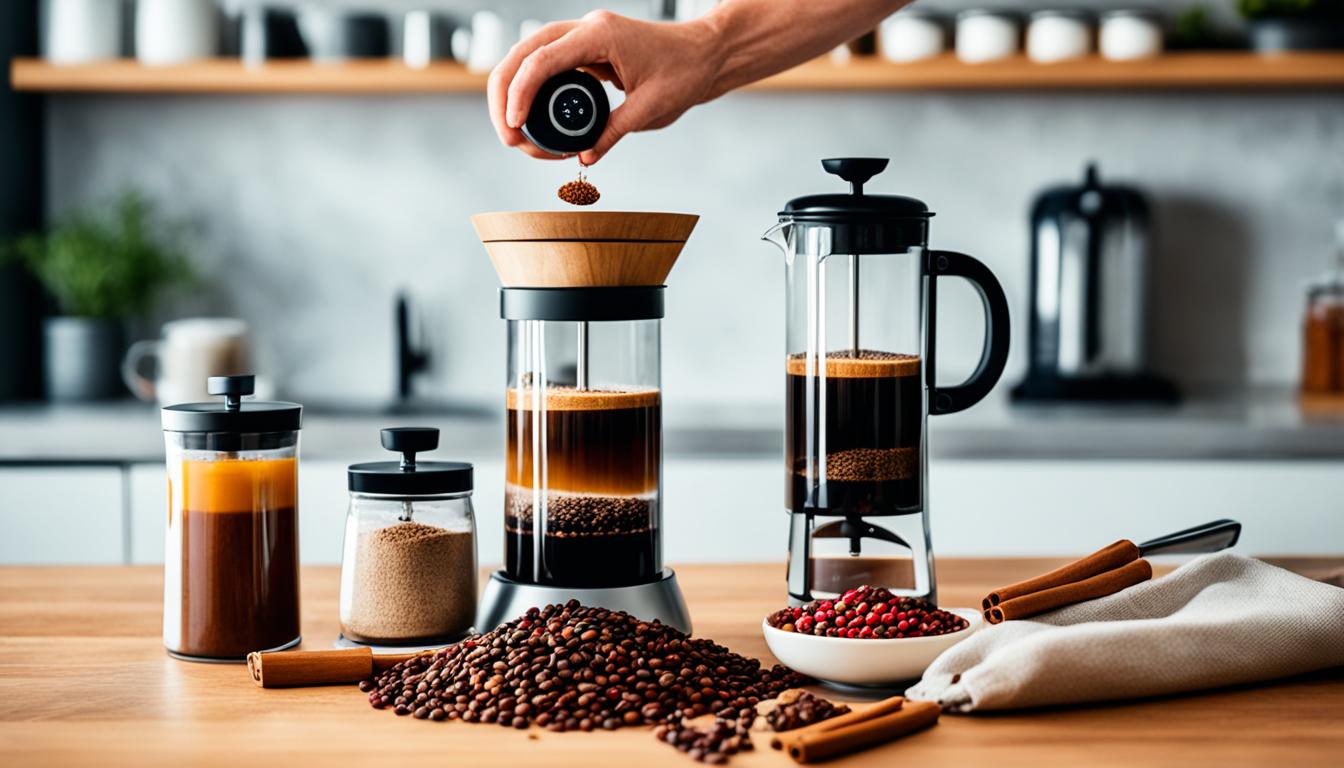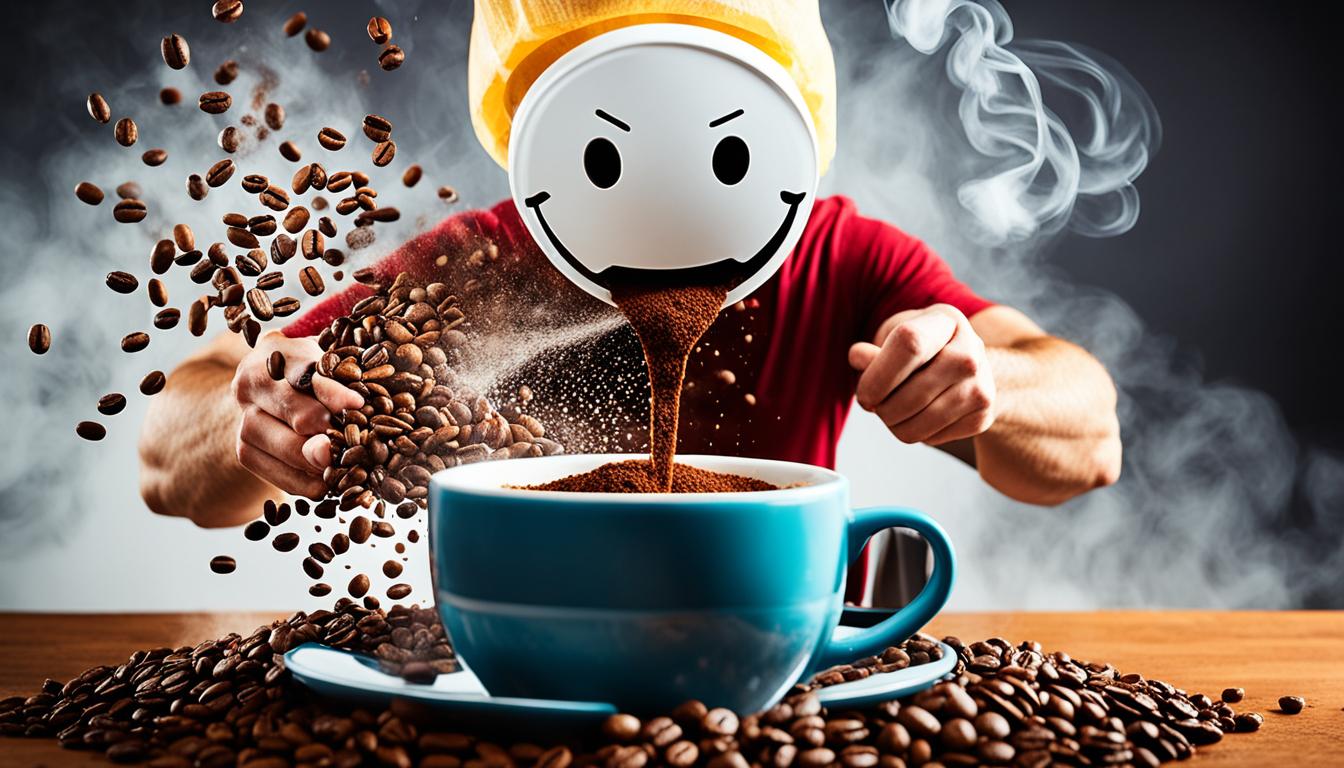Welcome to our guide on espresso brewing basics! If you’re a coffee lover looking to elevate your home-brewed espresso game, you’ve come to the right place. In this article, we’ll walk you through the essential techniques and considerations for making a perfect shot of espresso from the comfort of your own kitchen.
Espresso, with its rich and bold flavor, forms the foundation of many beloved coffee beverages like lattes, cappuccinos, and Americanos. Mastering the art of brewing espresso not only allows you to enjoy your favorite coffee drinks at home but also opens up a world of creative possibilities.
When it comes to making great espresso, attention to detail is key. From the extraction time and coffee dose to the final volume, every parameter plays a crucial role in achieving the perfect shot. But don’t worry, we’ll break it all down for you.
Key Takeaways:
- Espresso is a 30 ml coffee beverage that forms the base of popular drinks like lattes and cappuccinos.
- Mastering espresso brewing requires dedication, attention to detail, and consistency.
- The key parameters of espresso include extraction time, coffee dose, and final volume.
- Equipment and ingredients like an espresso machine, fresh coffee beans, grinder, tamper, and scale are essential for brewing espresso at home.
- Experiment with different grind sizes, coffee doses, and water amounts to find your perfect combination.
The Essentials for Brewing Espresso at Home
To brew espresso at home, you need to ensure you have the right equipment and ingredients. This includes an espresso machine or stovetop pot for brewing, fresh coffee beans, a grinder, a tamper, and a scale for accurate measurements. The quality of your espresso machine is crucial for maintaining the correct brewing temperature and pressure. It is also important to choose the right blend of coffee beans and grind them to the correct consistency. Experimentation is key to finding the best combination of grind, coffee dose, and water amount to achieve a perfect shot.
When it comes to brewing espresso at home, having the right equipment can make all the difference. An espresso machine helps you control the brewing temperature and pressure, allowing for a more consistent and flavorful result. If you prefer a more traditional approach, a stovetop pot can also be used to brew espresso.
Fresh coffee beans are a must for a great espresso. Look for high-quality beans with a roast profile that suits your taste preferences. It’s recommended to purchase whole beans and grind them just before brewing to preserve the flavors and aromas. Investing in a burr grinder ensures a consistent grind size for optimal extraction.
Using a tamper is essential to achieve the correct pressure during the brewing process. This tool helps compact the coffee grounds evenly in the portafilter, allowing for an even extraction. A scale is also necessary for precise measurements. Measuring the coffee dose and water amount ensures consistency in your brewing recipe each time.
Now that you have the essentials, it’s time to experiment! Start by adjusting the grind size. Finer grinds extract faster, while coarser grinds extract slower. Aim for a brew time of around 25-30 seconds for a balanced shot.
“The smell of freshly brewed espresso is irresistible.”
Explore different combinations of grind size, coffee dose, and water amount to find the best brewing technique for your taste. Keep in mind that small adjustments can significantly impact the taste and quality of your espresso. Don’t be afraid to experiment and find what works best for you.
Remember, brewing espresso at home is an art that requires practice and patience. The perfect shot may not come on the first try, but with time and dedication, you’ll be able to master the art of espresso brewing and enjoy cafe-quality drinks in the comfort of your own home.
Step-by-Step Guide to Brewing Espresso
Follow these 14 steps to master the art of brewing espresso at home:
- Start with freshly roasted coffee beans to ensure optimal flavor.
- Grind the coffee beans to a fine consistency, similar to granulated sugar.
- Preheat your espresso machine by running water through it for a few seconds.
- Measure the appropriate amount of coffee grounds based on your taste preferences and the size of your portafilter. For a single shot, use around 18 grams; for a double shot, use around 36 grams.
- Distribute the coffee grounds evenly in the portafilter, using a distribution tool or your fingers.
- Tamp the coffee grounds firmly and evenly, applying around 30 pounds of pressure, to create a level and compacted bed.
- Wipe off any excess coffee grounds from the rim of the portafilter to ensure a clean seal.
- Insert the portafilter into the group head, ensuring a secure fit.
- Place your espresso cup or shot glass underneath the portafilter to collect the extracted espresso.
- Start the brewing process by pressing the extraction button or lever on your machine.
- Monitor the extraction time and aim for a total time of 25-30 seconds.
- Observe the flow of espresso into the cup or shot glass. A smooth, even stream indicates proper extraction.
- Adjust the grind size, dose, or extraction time as needed to achieve the desired flavor profile.
- Enjoy your freshly brewed espresso shot as is, or use it as the foundation for other delightful espresso-based creations.
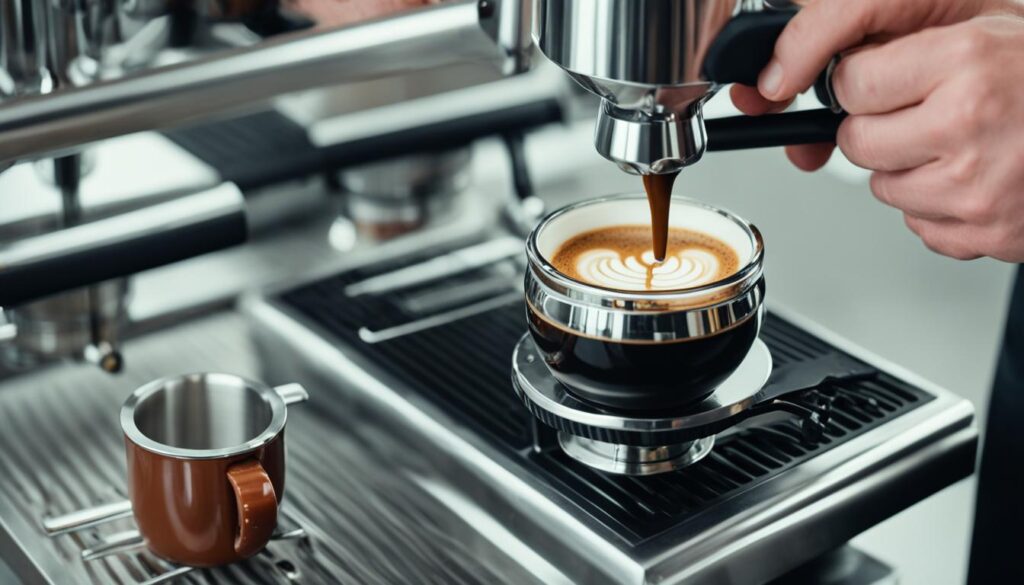
The Art of Espresso Extraction
When it comes to perfecting your espresso shots, the art of extraction plays a crucial role. A harmonious blend of various elements, from the coffee beans to the brewing technique, contributes to a rich and flavorful espresso experience. In this section, we will delve into the key factors that influence the extraction process and share some valuable tips and techniques for brewing the perfect espresso shot.
Understanding the Blend of Coffee Beans
The blend of coffee beans you choose for your espresso forms the foundation of the extraction process. Opt for a complex blend that combines different flavors and characteristics, such as body, richness, acidity, and brightness. This diversity of flavors will contribute to a well-rounded and satisfying espresso shot.
Controlling Grind Size for Optimal Flow
The grind size of your coffee grounds is crucial for controlling the flow rate of water through the coffee bed during extraction. Find the sweet spot by experimenting with different grind sizes until you achieve the desired flow rate and extraction time. A finer grind will slow down the flow, while a coarser grind will speed it up.
The Importance of a High-Quality Espresso Machine
An espresso machine or maker that provides the correct brewing temperature and pressure is essential for achieving consistent and delicious espresso shots. Investing in a high-quality machine will ensure that you have better control over these crucial parameters and allow you to fine-tune your brewing process.
Mastering the Technique
The technique used by the barista or home brewer has a significant impact on the quality of espresso extraction. Pay attention to key steps like coffee distribution, tamping, and pulling the shot. Consistency and precision in these actions will result in a well-extracted espresso shot with a rich crema.
“The secret to great espresso lies in the details. Every element, from the coffee beans to the machine and technique, must align to create a masterpiece in the cup.”
Remember, perfecting espresso extraction is an ongoing journey that requires practice and experimentation. By fine-tuning each element of the process and paying attention to the details, you can elevate your espresso brewing to new heights and indulge in the perfect espresso shot every time.
Understanding Recipe Elements: Dose, Yield, and Time
A good espresso recipe consists of three essential elements: dose, yield, and time. Each of these factors plays a crucial role in achieving the perfect espresso shot. By understanding and controlling these recipe elements, you can take your espresso brewing skills to the next level.
Dose
Dose refers to the amount of ground coffee used in the brewing process. It is measured in grams and determines the strength and flavor intensity of your espresso shot. The recommended dose can vary depending on the size of the basket used in your espresso machine. Generally, single baskets require 7-10 grams of coffee, while double baskets require 16-18 grams. Adjusting the dose allows you to personalize your espresso recipe according to your taste preferences.
Yield
Yield refers to the total weight of the liquid espresso produced. It is also measured in grams and represents the amount of espresso extracted from the coffee grounds. The yield is influenced by factors such as dose, grind size, and extraction time. A popular brew ratio is 1:1.5, meaning for every 20 grams of coffee used (dose), 30 grams of liquid espresso is produced (yield). However, the yield can be adjusted based on individual taste preferences, achieving a more concentrated or diluted espresso.
Time
Time plays a crucial role in espresso extraction. It refers to the total number of seconds it takes for the shot to be extracted. The ideal extraction time for an espresso shot is commonly accepted to be between 25-30 seconds. This range ensures a balanced extraction, capturing the desirable flavors and aromas from the coffee while avoiding over-extraction or under-extraction. Adjusting the extraction time allows you to fine-tune the taste profile of your espresso shot.
By manipulating the dose, yield, and extraction time, you can experiment and create unique espresso recipes tailored to your preferences. Remember, the best espresso recipe is the one that brings you joy with every sip.
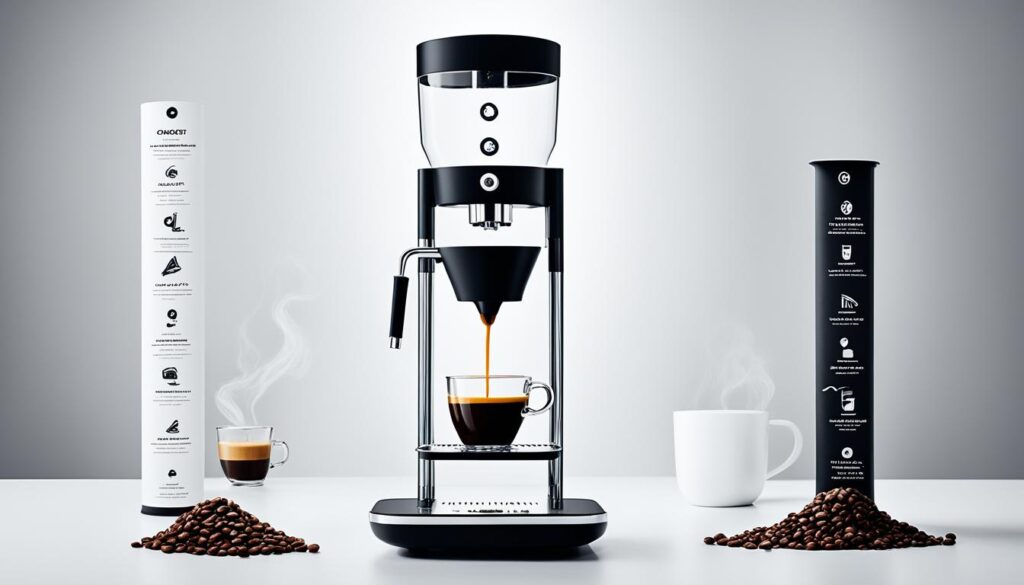
(Image description: A visual representation of espresso measurements, showcasing the importance of dose, yield, and time in brewing the perfect espresso shot.)
Conclusion
Mastering the art of espresso brewing and achieving the perfect espresso at home requires time, practice, and attention to detail. By following the basic parameters and experimenting with different techniques, you can unlock the secrets to a sublime shot of espresso every time.
Start by using fresh coffee beans and grinding them to the correct consistency. Pay close attention to the dose, yield, and extraction time to ensure optimal results. Adjust these factors according to your personal taste preferences, as brewing espresso is an art that can be tailored to individual preferences.
With patience, persistence, and a willingness to refine your skills, you can become a true espresso connoisseur. Imagine starting your day with the aroma of freshly brewed espresso, indulging in rich, velvety crema, and savoring the bold flavors that only a perfectly brewed espresso can deliver. With a little practice, you’ll be able to replicate the best espresso drinks from your favorite coffee shops right in the comfort of your own home.
FAQ
What is espresso?
Espresso is a 30 ml coffee beverage that is the heart of many popular drinks like lattes, cappuccinos, and Americanos.
What are the basic parameters of an espresso?
The basic parameters of an espresso include extraction time, dose of dry coffee grounds, and final volume.
What equipment do I need to brew espresso at home?
To brew espresso at home, you need an espresso machine or stovetop pot, fresh coffee beans, a grinder, a tamper, and a scale for accurate measurements.
How do I choose the right blend of coffee beans?
The blend of coffee beans should be complex, combining body, richness, acidity, and brightness.
How do I adjust the grind size for espresso?
The grind size should be adjusted to control the flow rate of water through the coffee bed.
What is a good espresso recipe?
A good espresso recipe consists of three main elements: dose, yield, and time.
How much coffee should I use for a single shot of espresso?
Single baskets typically require 7-10 grams of coffee.
How do I achieve the ideal extraction time for espresso?
The ideal range for extraction time is 25-30 seconds.
How can I perfect my espresso brewing technique?
Perfecting espresso brewing takes time, practice, and attention to detail. Experiment with different techniques and adjustments.
How do I unlock the art of perfect espresso brewing?
By following the basic parameters, experimenting with different techniques, and mastering the steps involved, you can achieve a sublime shot of espresso every time.
How can I enjoy the best espresso drinks at home?
Use fresh coffee beans, grind them to the correct consistency, and pay attention to the dose, yield, and extraction time.

